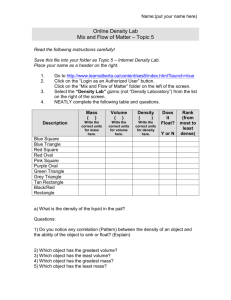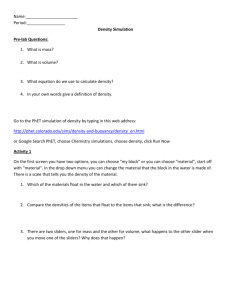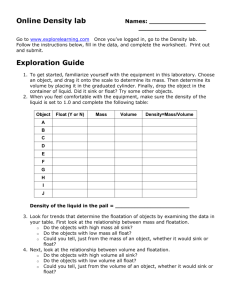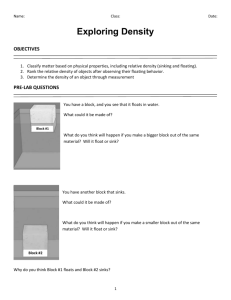Density Worksheet: Sink or Float Experiment
advertisement
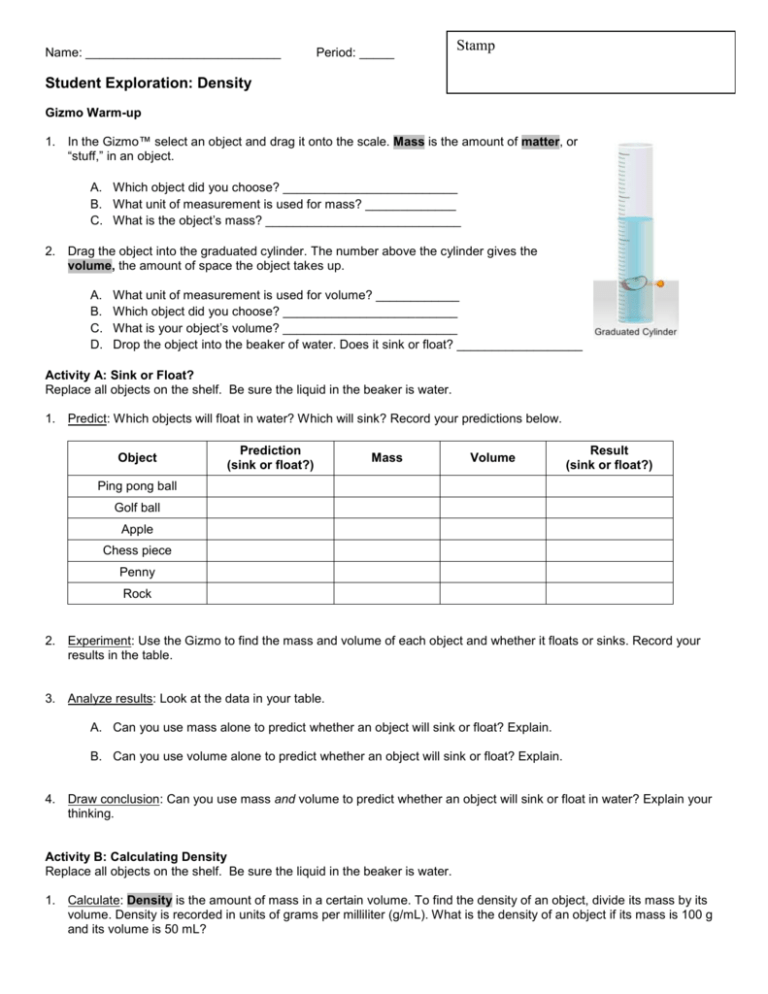
Name: ____________________________ Period: _____ Stamp Student Exploration: Density Gizmo Warm-up 1. In the Gizmo™ select an object and drag it onto the scale. Mass is the amount of matter, or “stuff,” in an object. A. Which object did you choose? _________________________ B. What unit of measurement is used for mass? _____________ C. What is the object’s mass? ____________________________ 2. Drag the object into the graduated cylinder. The number above the cylinder gives the volume, the amount of space the object takes up. A. B. C. D. What unit of measurement is used for volume? ____________ Which object did you choose? _________________________ What is your object’s volume? _________________________ Drop the object into the beaker of water. Does it sink or float? __________________ Activity A: Sink or Float? Replace all objects on the shelf. Be sure the liquid in the beaker is water. 1. Predict: Which objects will float in water? Which will sink? Record your predictions below. Object Prediction (sink or float?) Mass Volume Result (sink or float?) Ping pong ball Golf ball Apple Chess piece Penny Rock 2. Experiment: Use the Gizmo to find the mass and volume of each object and whether it floats or sinks. Record your results in the table. 3. Analyze results: Look at the data in your table. A. Can you use mass alone to predict whether an object will sink or float? Explain. B. Can you use volume alone to predict whether an object will sink or float? Explain. 4. Draw conclusion: Can you use mass and volume to predict whether an object will sink or float in water? Explain your thinking. Activity B: Calculating Density Replace all objects on the shelf. Be sure the liquid in the beaker is water. 1. Calculate: Density is the amount of mass in a certain volume. To find the density of an object, divide its mass by its volume. Density is recorded in units of grams per milliliter (g/mL). What is the density of an object if its mass is 100 g and its volume is 50 mL? 2. Record data: In the Gizmo, find mass and volume of the objects listed below. Then calculate each object’s density and record it. Finally, test whether each one sinks or floats in water. Object Density Sink or Float? Chess piece Rock Toy soldier Apple 3. Draw conclusion: The density of water is 1.0 g/mL. Look at the data in your table. How can you use the density of an object to predict whether it will sink or float? 4. Apply: In the Gizmo, either Crown 1 or Crown 2 is solid gold (but not both). Find the density of the gold nugget and of each crown. A. B. C. D. Density of the gold nugget:_______________ Density of Crown 1: ____________________ Density of Crown 2: ____________________ Which crown is pure gold? _______________ Activity C: Egg-speriment Replace all objects on the shelf. 1. Observe: Use the Gizmo to explore whether the egg sinks or floats in different liquids. Record what you find in the table below. Liquid Water Oil Gasoline Seawater Corn Syrup Sink or Float? 2. Draw conclusion: Which liquids are denser than the egg? Which are less dense? Explain your reasoning. More dense: Less dense: 3. Extend your thinking: Observe the egg in each liquid again. A. In which liquid does the egg float the highest? B. In which liquid does the egg sink the fastest? C. Which liquid do you think is the densest? Least dense? Explain. 4. Challenge yourself: Using the objects in the Gizmo to help you, list the liquids from densest to least dense.

